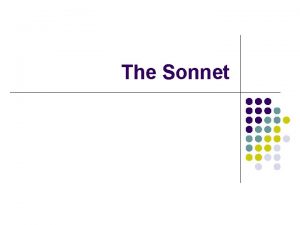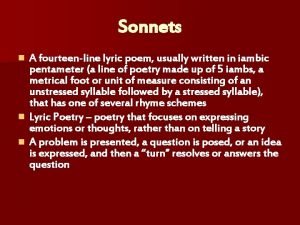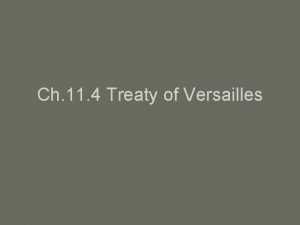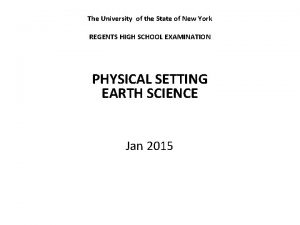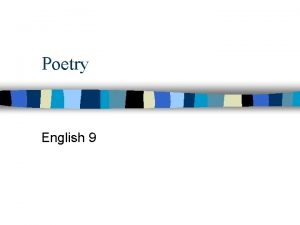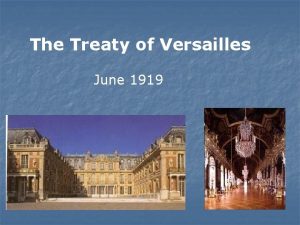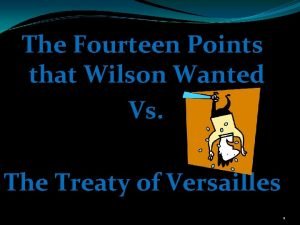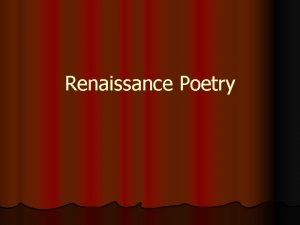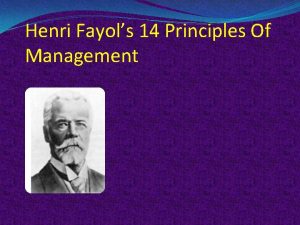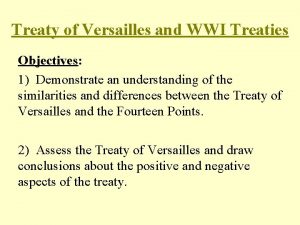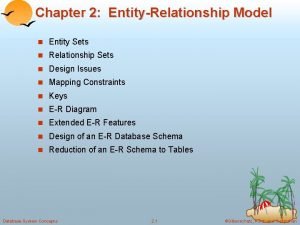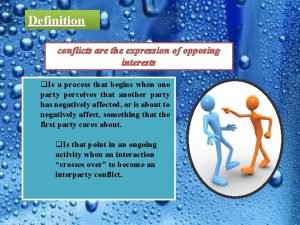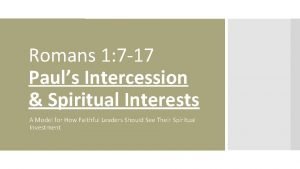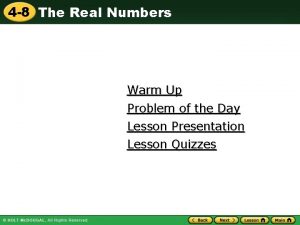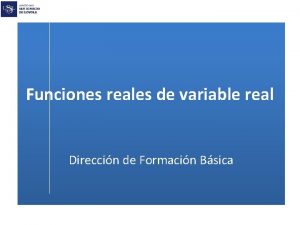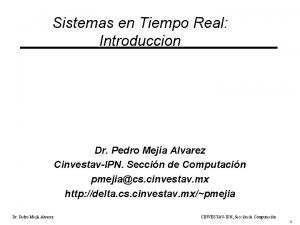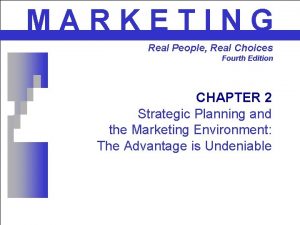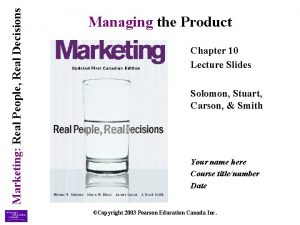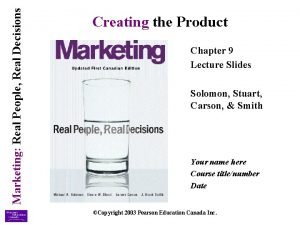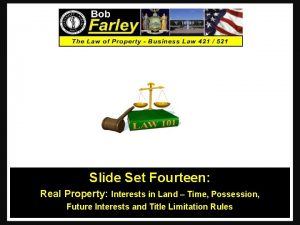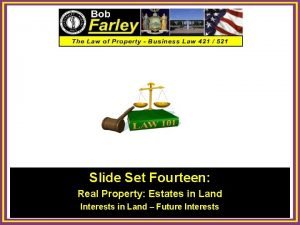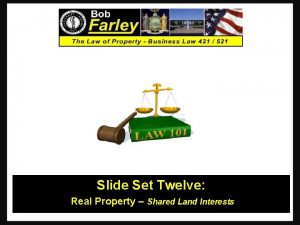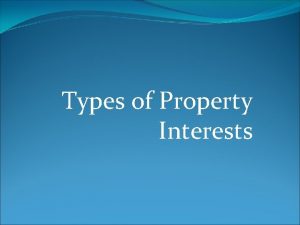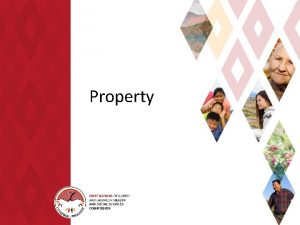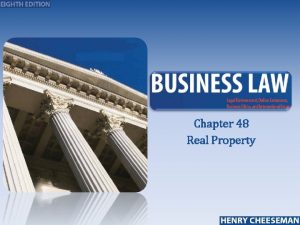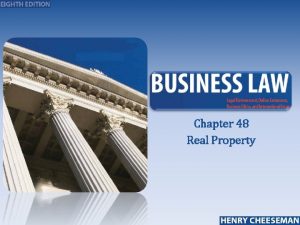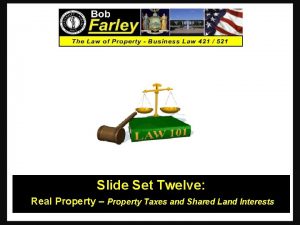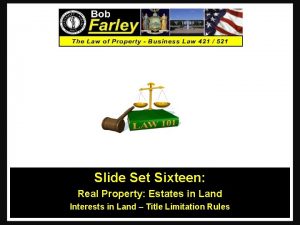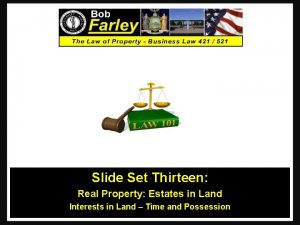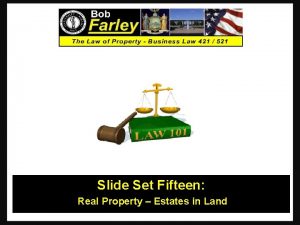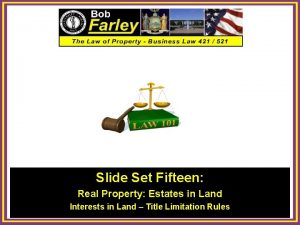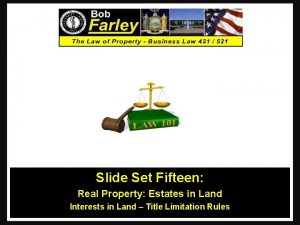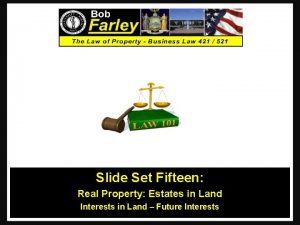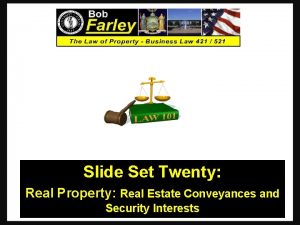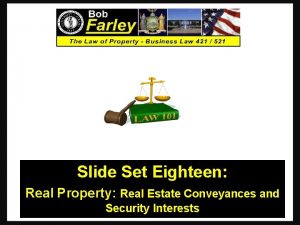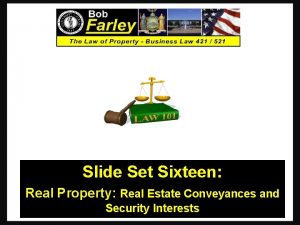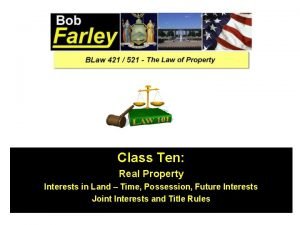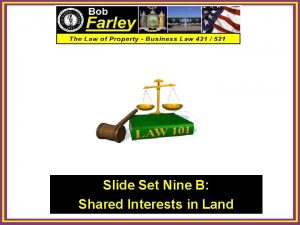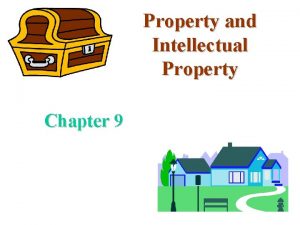Slide Set Fourteen Real Property Interests in Land



































































- Slides: 67

Slide Set Fourteen: Real Property: Interests in Land – Time, Possession, Future Interests and Title Limitation Rules 1

Last Class: • We will begin to discuss Real Property Concepts - Real Property – The Basics - Definitions of Real Property - The Importance of Real Property - Nature of Interests in Real Property - Possessory Estates vs. Non Possessory - Estates in Time – Duration of Rights - Collection of Rights - Shared Rights in Land - Real Property Taxes 2

Tonight’s Class: • We Will Discuss: - The Nature, Definitions and Explanation of Estates in Land Possessory Interests in Land 1. Fee Simple Absolute 2. Defeasible Estates 3. Fee Tail 4. Life Estate Non possessory interests in land: 1. Easements, 2. Profits, 3. Covenants, and 4. Servitudes - Future Interests - Estates in Time 1. Life Estates, 2. Possibility of Reverters, and 3. Rights of Re-Entry - Title Limitation Rules - Rule in Shelley’s Case - Doctrine of Worthier Title - Rule Against Perpetuities - Rule Against Restraints on Alienation 3

• Real Property – A Review of the Basics - Real Property is very Important and Valuable – Real Property has historically meant Wealth, Power and Life - To truly understand Real Property, and its importance and value, we need to think in terms of Possession and Time - The concepts of Ownership and Limitations on Ownership are fundamental for an understanding of Real Property, because of its importance and value. - The value of Real Property has led to complex legal rules - Fee Ownership – Estates in Land – is the foundational platform for real property. - Because of its value, the law has recognized Concurrent Property Ownership, and authorizes Real Property Taxes 4

First: The Nature of Interests in Real Property Estates in Land 5

Estates in Land So just what is an Estate in Land? An Estate in land is an “Interest in Land” that relates to your Collection of Rights with respect to the Real Property in question. Real Property has always been held as: - Valuable, - Special, - Distinct, and - Unique, under the law. Accordingly, the law has long recognized that Rights in such Real Property are to be viewed as Extensive and Severable, and as such, can also be limited in its Transference, by the original owner. 6

Estates in Land So just what is an Estate in Land? • When you have an ownership interest in the land, you maintain a Collection of Rights with respect to the Real Property in question. • These Rights, and their Limitations, of an Estate in Land, include: – – – Exclusion Possession Use; and Transfer; as well as Time 7

Estates in Land So just what is an Estate in Land? • To determine the rights and limitations conveyed, in an Estate in Land, it is necessary to look at the property rights in terms of: 1. Titled Ownership, and 2. Limitations Titled on Ownership • The inherent value of Real Property has therefore led to complex legal rules to provide these rights and limitations and their conveyance. 8

Estates in Land So just what is an Estate in Land? • A Two Step Dance: Possession and Time (Two Major Questions – Must be asked to determine the Interest) Step One: Form of Possession (Possession – Does the interest allow possession of the realty? ) ● Possessory Interests in Land (Either presently or in the future) ● Non - Possessory Interests in Land (Either presently or in the future) Step Two: When the Interest Vests ● Present Interests (When the RIGHT to possess is NOW) ● Future interests (When the RIGHT to possess is in the future) 9

Types of Estates in Land • Possessory Interests in Land (Either presently or in the future) 1. Fee Simple Absolute 2. Defeasible Estates - Fee Simple Determinable with Possibility of Reverter - Fee Simple Subject to a Condition Precedent - Fee Simple Subject to an Executory Interest 3. Fee Tail 4. Life Estate • Non possessory interests in land: (An Interest with a right that can be executed but is not presently possessed) 1. Easements 2. Profits, 3. Covenants, and 4. Servitudes 10

Estates in Land What is the meaning of the term FEE? ? ● The term derives from English Common Law: ● Under Common Law, the King had radical title or “allodium” over all English lands. ● Such title meant that the King was the ultimate "owner" of all Real Property. ● The King, could, however, grant an abstract entity (known as an Estate in Land) to a subject. ● This Estate in Land would be effectively “owned and possessed” by the subject granted the estate. ● The grant of the Estate in Land by the King was known as a Fee. ● The fee simple estate, also called "estate in fee simple" or "fee-simple title" is sometimes simply known or referred to as a ”freehold” 11

Estates in Land What is the meaning of the term FEE? ? Continued ● The term derives from English Common Law: ● In the early period after the Norman conquest, the holder of an estate in fee simple could not sell it, but instead could only grant a subordinate fee simple estate to a third party in the same parcel of land – this was a process known as “subinfeudation” where the King still maintained ultimate ownership power over the land. ● The Statute of Quia Emptores, adopted by Parliament in 1290, abolished subinfeudation and allowed the sale of fee simple estates. ● This was another offshoot of the Magna Carta 75 years earlier. ● Later William Blackstone, the great common law commentator, would define land held in fee simple as: • An estate in land held by the owners and theirs absolutely; • An estate in land without any end or limit; • An estate in land can be conveyed to whomsoever the owner pleases; • An estate in land can be mortgaged or put up as security; and • An estate in land can be reduced to any other type of lesser estate. 12

Types of Estates in Land • Possessory Interests in Land (Either presently or in the future) 1. Fee Simple Absolute 2. Defeasible Estates - Fee Simple Determinable with Possibility of Reverter - Fee Simple Subject to a Condition Precedent - Fee Simple Subject to an Executory Interest 3. Fee Tail 4. Life Estate • Non possessory interests in land: (An Interest with a right that can be executed but is not presently possessed) 1. Easements 2. Profits, 3. Covenants, and 4. Servitudes 13

Words of Purchase vs. Words of Limitation ● Today, we no longer have the ceremony of Livery of Seizen. ● Title to Real Property is conveyed by means of a written deed. ● As a result, to determine what rights exist in an Estate in Land, there are two factors in the deed which tell the story: • Words of purchase: who Describe takes the real property by grant, gift, inheritance or bequest. • Words of limitation: type duration Describe the and of the estate taken by the transferee. 14

Estates in Land – Possessory Interests in Land (Possessed either presently or in the future) 1. Fee Simple Absolute 2. Defeasible Estates - Fee Simple Determinable with Possibility of Reverter - Fee Simple Subject to a Condition Precedent - Fee Simple Subject to an Executory Interest 3. Fee Tail 4. Life Estate 15

Estates in Land – Possessory Interests What goes in the deed for words of purchase and words of limitation ● Present, possessory interest. ● Highest Level Estate in Land: FEE SIMPLE ABSOLUTE 1. Invests the owner with all possible rights (E-PUT) now and in the future. 2. It is the presumed form of ownership grant, unless a lesser estate grant was expressly intended. 3. Is of perpetual and infinite duration (lasts forever). 4. Is the form of ownership from which all lesser forms are derived. Magic Language: “To Grantee and theirs” 16

Fee Simple Absolute “To A and his heirs” • What are the words of purchase? • What are the words of limitation? To A Words of purchase and his heirs Words of limitation Infinity 17

What are the critical attributes of Fee Simple Absolute? When a transfer is made to A and his heirs: Alienable (Able to be sold/gifted), Reducible (Able to be reduced to a lesser estate) Devisable (Able to be given by will or intestate), and Lasts for Perpetuity (Forever – No Limitation of Time). 18

Estates in Land – Possessory Interests What goes in the deed for words of purchase and words of limitation ● Present, possessory interest. ● Next to Highest Level Estate in Land: ● Defeasible Estate: - These are possessory fee estates of infinite duration that can be terminated by the happening of a specified event. - These are a lesser estate than fee simple absolute. FEE SIMPLE DETERMINABLE (Possibility of Reverter) 1. An Estate that AUTOMATICALLY terminates upon the happening of a stated event. 2. Stated event must be for a lawful purpose. Magic Language: “To Grantee and theirs for so long as” or “while” or “during” or “until” (the occurrence of an event). 19

Fee Simple Determinable “To A and his heirs for so long as …” • What are the words of purchase? • What are the words of limitation? To A Words of purchase and his heirs for so long as … Words of limitation Infinity 20

What are the critical attributes of Fee Simple Determinable? When a transfer is made to A and his heirs for so long as … : All Subject to the Possibility of Reveter Alienable (Able to be sold/gifted), Reducible (Able to be reduced to a lesser estate) Devisable (Able to be given by will or intestate), and Lasts for “So Long As” (The Limitation of The Reverter). 21

Estates in Land – Possessory Interests What goes in the deed for words of purchase and words of limitation ● Present, possessory interest. ● Next to Highest Level Estate in Land: ● Defeasible Estate: - These are possessory fee estates of infinite duration that can be terminated by the happening of a specified event. - These are a lesser estate than fee simple absolute. FEE SIMPLE SUBJECT TO A CONDITION SUBSEQUENT 1. An Estate that can terminate upon the happening of a stated event and the taking of an action by the party granted such rights by the transferring owner. 2. Known as a RIGHT OF RE-ENTRY, this termination is NOT AUTOMATIC and needs the grantor to take action Magic Language: “To Grantee and theirs upon the condition that” or “provided that” or “but if” or “if it 22 happens that” (the occurrence of an event).

Estates in Land – Possessory Interests • Defeasible Estates Continued FEE SIMPLE SUBJECT TO A CONDITION SUBSEQUENT - A RIGHT of RE-ENTRY CAN be waived (unlike Fee Simple Determinable which is automatic) by express agreement or by conduct. - Although inaction by itself is NOT a waiver, where there is inaction, and detrimental reliance, courts have held a waiver by the grantor pursuant to the doctrine of estoppel. - The rights of a Fee Simple Subject to a Condition Subsequent have been held to be devisable, but NON TRANSFERABLE. 23

Fee Simple Subject to Condition Subsequent “To A and his heirs upon the condition that …” • What are the words of purchase? • What are the words of limitation? To A Words of purchase and his heirs upon the condition that … Words of limitation Infinity 24

What are the critical attributes of Fee Simple Subject to a Condition Subsequent? When a transfer is made to A and his heirs upon the condition that … : All Subject to the Right of Re-entry Alienable (Able to be sold/gifted), Reducible (Able to be reduced to a lesser estate) Devisable (Able to be given by will or intestate), and Lasts until the condition arises AND the Right of Re-entry is exercised. 25

Estates in Land – Possessory Interests • Defeasible Estates FEE SIMPLE SUBJECT TO AN EXECUTORY INTEREST - A Defeasible Estate that AUTOMATICALLY divests in favor of a THIRD PERSON upon the happening of a stated event. - Different from a FEE SIMPLE DETERMINABLE in that this estate does not revert to the grantor but to a 3 rd PERSON. - Subject to the Rule Against Perpetuities. - Title passes to a third party in the event that the Condition is satisfied. 26

Estates in Land – Possessory Interests • Defeasible Estates LIMITATIONS - Possibility of Reverters and Rights of Re-entry have been limited by most states to foster the marketability of title. A free society needs the ability to freely transfer property, and not impair the title of the same from transactions which occurred years ago. - DIRECT STATUTORY PRECLUSIONS (usually 30 years) - RULE AGAINST PERPETUITIES (21 years plus lives in being) - RULE IN SHELLEY’S CASE (Remainder limited to heirs or heirs of the body) - DOCTRINE OF WORTHIER TITLE (Remainder invalid, Grantor retains reversion) 27

Estates in Land – Possessory Interests Present, Possessory Interests. FEE TAIL 1. An Estate limited to the grantee and his or her family 2. Reverts to grantor if not owned by heir 3. No longer recognized in almost any state Magic Language: “To Grantee and heirs of their body” Now FEE SIMPLE ABSOLUTE 28

Estates in Land – Possessory Interests Present, Possessory interests. LIFE ESTATE 1. By Marital Right (Dower and Curtsey) 2. For Life of Grantee 3. Pur Autre Vie (Life of Another) Magic Language: “To Grantee for Life” or “To Grantee for the Life of Tilda Spain” 29

Life Estate “To A for Life…” • What are the words of purchase? • What are the words of limitation? To A Words of purchase for life… Words of limitation Infinity 30

Estates in Land – Non Possessory Interests Until now we have discussed “Possessory Interests”, meaning interests in real property that either ARE, or WILL BE (pre-vested interests) POSSESSED by the holder of the property. Just as there are possessory interests in real property where possession is not effectuated yet because of time or condition, the law also recognizes interests in real property where the holder of such interest does NOT EVER actually POSSESS the property. Such are interests are deemed “Non - Possessory Interests” 31

Estates in Land – Non Possessory Interests • Easements • Profits • Covenants • Servitudes 32

Future Interests 33

Future Interests - Estates in Time - Life Estates The remainder is the estate in time. - Possibility of Reverters The reversion is the estate in time. - Rights of Re-Entry The right of re-entry is the estate in time. 34

Future Interests – Estates in Time • Like all property, interests in land are a collection of rights • Interests in Land need to be seen through the prism of: – – Possession Time Two Major Questions • Possession – Does the interest allow possession of the realty? • Time – What time will the interest in the property be executed? This time factor is the critical question when dealing with “Future Interests” 35

Future Interests – Estates in Time Remember – We need to think of possession & time Black’s Law Dictionary – Definition Future Interests: “Interests in land or other things in which the privilege of possession or of enjoyment is future or non present. ” The real property rights that are left over from the granting of an interest 36

As a result … Possessory Interests in Land Can be: Present Possessory Interests or Future Interests 37

Estates in Land So just how are Future Interests Determined? • A Two Step Dance: Possession and Time (Two Major Questions – Must be asked to determine the Interest) Step One: Form of Possession (Possession – Does the interest allow possession of the realty? ) ● Possessory Interests in Land (Either presently or in the future) ● Non - Possessory Interests in Land (Either presently or in the future) Step Two: When the Interest Vests ● Present Interests (When the RIGHT to possess is NOW) ● Future interests (When the RIGHT to possess is in the future) 38

Types of Future Interests • Reversionary Interests • Reversions • Possibility of Reverter • Right of Re-entry • Remainders 39

Explanations of Future Interests • Reversionary Interests – Reversion The residue (or future interest) of an estate left by operation of law in the grantor or his heirs. Examples/Explanation: When any lesser estate is created from the fee simple absolute, the reversion is legal rights in the estate that the grantor or his heirs are entitled to after such creation, including remainders or executory interests, vesting in the grantor of his heirs. The key is that such legal interest RETURNS to the grantor or his heirs. 40

Explanations of Future Interests • Reversionary Interests – Possibility of Reverter A specific type of reversion, pursuant to a fee simple determinable, whereby the estate AUTOMATICALLY returns to grantor of his heirs upon the happening of a stated, legal, event. Examples/Explanation: When a grantor transfers an estate to the grantee for so long as the property remains an active, cultivated farm, if the grantee stops using such property for such legal purpose, the parcel automatically reverts back to the grantor or his heirs. 41

Explanations of Future Interests • Reversionary Interests – Right of Re-entry A specific type of reversion, pursuant to a fee simple subject to a condition subsequent, whereby the grantor or his heirs have a right to reclaim the estate upon the happening of a stated, legal, event. Examples/Explanation: When a grantor transfers an estate to the grantee upon the condition that the property remains an active, cultivated farm, if the grantee stops using such property for such legal purpose, then the grantor or his heirs can exercise a right to reclaim full title to the parcel. 42

Explanations of Future Interests • Remainders –Remainder The remnant (or future interest) of an estate depending upon a particular prior estate created at the same time and by the same instrument, and limited to arise immediately on the determination of that estate, and not in abridgement of it. In other words, a remainder is a future interest limited in favor of a transferee, which may become possessory immediately upon the termination (upon the happening of a limitation) of a prior possessory estate simultaneously created Examples/Explanation: Those rights in an estate which are left over (i. e. that remain) from the creation of a lesser estate. 43

Explanations of Future Interests • Remainders –Remainders v. Reversions are special remainders, whereby the remainder vests in the grantee or his heirs. As a result, all reversions are remainders, but NOT all remainders are reversions. Examples/Explanation: In the case of a reversion, the remainder is those rights in an estate which are left over (i. e. that remain) from the creation of a lesser estate and vest in the grantor of his heirs. In a remainder that is not a reversion, such is where such rights vest in another person who is NOT the grantor or his heirs. 44

Title Limitation Rules 45

Title Limitation Rules • • Rule in Shelley’s Case Doctrine of Worthier Title Rule Against Perpetuities Rule Against Restraints on Alienation These Rules All Seek to Promote Marketable Title and Ensure that Real Property is NOT Controlled for any significant time from Beyond the Grave 46

RULE IN SHELLY’S CASE • Wolfe v. Shelley, 1 Co. Rep. 93 b, 76 Eng. Rep. 206 (C. P. ), generally known as Shelley's Case • In 1581 England, in an attempt to avoid inheritance taxes, land transactions were being structured: To A for life, with a remainder to A’s heirs • Seeing through this legal fiction, the court held that since A could control the disposition of his estate (i. e. who would be his heirs), that any such transfer was really, and should be deemed to be: Now: To A in Fee Simple Absolute. 47

The Rule in Shelley’s Case As a Result: • If a life estate is created in A and a remainder is created in A’s heirs, the remainder is deemed to have been created in A rather than A’s heirs. • Now with the Rule in Shelley’s Case, A would have a life estate and the next vested estate, and they would merge to give A a fee simple absolute in the property. • Reasons for the rule? - Promote marketable title - End a legal fiction tax dodge 48

Doctrine of Worthier Title (Similar to Rule in Shelley’s Case, but with different parties) • Again in Common Law England, in an attempt to avoid inheritance taxes, land transactions were being structured: To A for life, with a remainder to O’s heirs • Seeing through this legal fiction, the courts held that since O could control the disposition of his estate (i. e. who would be his heirs), that any such transfer was really, and should be deemed to be: Now: To A for Life, with a Reversion to O. 49

Rule Against Perpetuities • The Rule Against Perpetuities is one of the most complicated Rules in the Law. Basically, common law disfavors and prevents property from being held perpetually in trust. 50

The Rule Against Perpetuities Statement of the Rule: • Any agreement with respect to the transfer of property (reversions, remainder, ect. ) is VOID which does not end twenty-one (21) years after a life in being at the time of the transfer (i. e. one generation from lives presently in being twenty-one years. ) 51

Rule Against Perpetuities Another way to describe this is: "No property interest shall be deemed valid unless it vests, if at all, not later than 21 years after some life in being at the time of the creation of the interest. “ An interest is "vested" when we know for sure that someone will receive, or fail to receive, the interest. 52

The Rule Against Perpetuities Explained: • This 21 years (which represents a generation) is an arbitrary time period merely intended as a breaker for the entanglement to estates and their title, so as to return such estates back to the preferred title of fee simple absolute. 53

The Rule Against Perpetuities Pursuant to this Rule “lives in being” include: 1. The holder of the interest; 2. The person creating the interest; 3. Any person who can affect a condition precedent attached to the interest; and 4. Any person who can affect the identify of the holder It should be noted that unborn babies, if born alive, are considered “lives in being” 54

The Rule Against Perpetuities 55

Rule Against Restraints on Alienation • This Rule was established and recognized under Common Law. It stated that: “Any restriction on the transferability of a legal (as distinguished from an equitable) interest in property is, and shall be deemed as, void. ” • A “Restraint on Alienation" means an express restriction on the future transferability of the real property. • Like the Rule Against Perpetuities, this is a Rule of public policy, that is designed to encourage the marketability of title, and prevent real property from being tied up and taken out of commerce. 56

Rule Against Restraints on Alienation There are three types of restraints on alienation: 1. Disabling restraints, which prohibit any future transfer; 2. Forfeiture restraints, under which an attempted transfer results in a forfeiture of the interest; and 3. Promissory restraints, under which an attempted transfer breaches a covenant. 57

Rule Against Restraints on Alienation Types of Restraints • ALL Disabling Restraints on Legal Interests Are VOID - Disabling restraints are seen as particularly offensive because: (i) Unlike the other types of restraints, transfers are totally prohibited; (ii) they enable a person to deny the validity of his own conveyance, and (iii) they exempt the property from the person's creditors even while he is enjoying the property. • ALL Absolute Restraints on Fee Simple Are VOID - Absolute restraints of whatever type on fee simple estates are void. - The grantee may ignore the restraint and freely transfer the property. 58

Rule Against Restraints on Alienation Exceptions to the Rule: • Partial Restraints on Fees Simple - Although absolute restraints on fee simple estates are held to be VOID, a restraint for a limited time and for a reasonable purpose is likely to be upheld. • Example and Explanation: A owns and resides in a house. He conveys a one-half interest in the house to his brother, B, including in the deed, a covenant that "during their joint lifetimes, each party promises not to convey his interest to any other person without the consent of the other party. " This promissory restraint is limited to the joint lifetimes of the parties and is a reasonable way to ensure that neither party will be faced with the prospect of having to reside with a stranger. This restraint would probably be upheld. 59

Rule Against Restraints on Alienation Exceptions to the Rule Continued: Forfeiture and Promissory Restraints on Life Estates Forfeiture and promissory restraints on life estates are VALID. A life estate is inalienable as a practical matter because few would be willing to pay full value for an estate of uncertain duration. As a result, little is lost by giving effect to the transferor's intention to restrict the estate's transferability. (However, Disabling restraints on legal life estates are void. ) 60

Rule Against Restraints on Alienation Exceptions to the Rule Continued: • Forfeiture Restraint on Transferability of a Future Interest A forfeiture restraint on the transferability of a future interest, during the period when the interest is still a future interest, is deemed to be VALID. 61

Rule Against Restraints on Alienation Exceptions to the Rule Continued: • Reasonable Restrictions in Commercial Transactions The courts tend to uphold restrictions on transferability that arise in the context of a commercial transaction on theory that the restriction appears in an agreement entered into by the parties, it is a product of their bargaining, and presumably serves a useful purpose in facilitating the parties' objectives. Thus, restrictions on transferability that are part of a bargained for agreement, as distinguished from a donative transaction, are deemed valid. 62

Rule Against Restraints on Alienation Exceptions to the Rule Continued: • Right of First Refusal The right to have the first opportunity to purchase Real Estate when it becomes available, or the right to meet any other offer, is valid if reasonable. ( i. e by specifying fair market value or other reasonable price). 63

Rule Against Restraints on Alienation Exceptions to the Rule Continued: • Restrictions on Transferability of Leaseholds A provision in a lease prohibiting the lessee's assignment or subletting of their leasehold interest without the consent of the landlord is given effect in all jurisdictions. • Spendthrift Clauses Are Valid The rule applicable to restrictions on alienation involving equitable interests (i. e. those held in trust) is the exact opposite of legal interests. As a result, Spendthrift clauses, which are true disabling restraints, are deemed VALID. 64

Title Limitation Rules • • Rule in Shelley’s Case Doctrine of Worthier Title Rule Against Perpetuities Rule Against Restraints on Alienation These Rules All Seek to Promote Marketable Title and Ensure that Real Property is NOT Controlled for any significant time from Beyond the Grave 65

Case Study: Dred Scott v. Sanford The case that caused a Civil War Roger Taney Dred Scott Benjamin Robbins Curtis 66

• Bonus Questions of the Day For next time – Read Assignments for Class One to Ten • Question of the Day • Questions? ? ? 67
 What are the basic dance steps in heel and toe polka
What are the basic dance steps in heel and toe polka Total set awareness set consideration set
Total set awareness set consideration set Training set validation set test set
Training set validation set test set An area of land largely enclosed by higher land
An area of land largely enclosed by higher land A pointed piece of land extending into the sea
A pointed piece of land extending into the sea Commutative property vs associative property
Commutative property vs associative property Sapratibandha daya and apratibandha daya
Sapratibandha daya and apratibandha daya Physical properties and chemical properties
Physical properties and chemical properties Not in a silver casket
Not in a silver casket A 14 line lyric poem written in iambic pentameter
A 14 line lyric poem written in iambic pentameter Eleven twelve thirteen fourteen fifteen
Eleven twelve thirteen fourteen fifteen Wilson's fourteen points and the treaty of versailles
Wilson's fourteen points and the treaty of versailles Isi wilson's fourteen points
Isi wilson's fourteen points What is octave and sestet
What is octave and sestet The diagram below represents the placoderm fish
The diagram below represents the placoderm fish A fourteen line poem with prescribed rhyme of scheme
A fourteen line poem with prescribed rhyme of scheme Siya ang may akda ng fourteen points
Siya ang may akda ng fourteen points Fourteen line lyric poem
Fourteen line lyric poem A 14 line lyric poem
A 14 line lyric poem Siya ang may akda ng fourteen points
Siya ang may akda ng fourteen points A fourteen line lyric poem
A fourteen line lyric poem Ano ang teoryang realismo?
Ano ang teoryang realismo? Fourteen one act play summary
Fourteen one act play summary Introduction of 14 principles of management
Introduction of 14 principles of management Fourteen points and treaty of versailles similarities
Fourteen points and treaty of versailles similarities Crosby quality is free
Crosby quality is free Why did president wilson propose his fourteen points
Why did president wilson propose his fourteen points The entity set is a *
The entity set is a * Hobbies outside of school
Hobbies outside of school Basic interests and hobbies
Basic interests and hobbies Difference between hobbies and interest
Difference between hobbies and interest Unifrog personality test
Unifrog personality test Stakeholders and their interests
Stakeholders and their interests Questions about leisure activities
Questions about leisure activities When i have free time i usually
When i have free time i usually Executory interest examples
Executory interest examples Functional conflict example
Functional conflict example Tiny rascal gang
Tiny rascal gang Difference between interests and hobbies
Difference between interests and hobbies What is your hobby? my hobby is
What is your hobby? my hobby is Describing hobbies
Describing hobbies Hobbies and interests of a teacher
Hobbies and interests of a teacher Spiritual interests
Spiritual interests Factoring slide and divide method
Factoring slide and divide method Bounded set vs centered set
Bounded set vs centered set Fucntions
Fucntions Crisp set vs fuzzy set
Crisp set vs fuzzy set Crisp set vs fuzzy set
Crisp set vs fuzzy set What is the overlap of data set 1 and data set 2?
What is the overlap of data set 1 and data set 2? Surjective vs injective
Surjective vs injective Commutative property definition
Commutative property definition Real property definition
Real property definition Density property of real numbers examples
Density property of real numbers examples Associative commutative identity
Associative commutative identity Tempo structured products
Tempo structured products Density property of real numbers
Density property of real numbers Associative property of real numbers
Associative property of real numbers Funcion de variable real
Funcion de variable real The real real fashion copywriter
The real real fashion copywriter Sensor and (tiempo real or real time)
Sensor and (tiempo real or real time) Real world application of polynomials
Real world application of polynomials Marketing: real people, real choices
Marketing: real people, real choices The real thing short story
The real thing short story Marketing real people real choices
Marketing real people real choices Real homes real estate
Real homes real estate Slidetodoc.com
Slidetodoc.com Marketing real people real decisions
Marketing real people real decisions Marketing real people real decisions
Marketing real people real decisions








